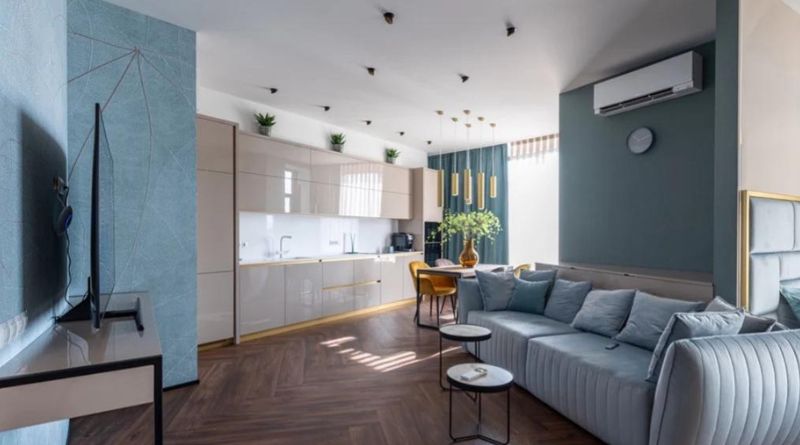The concept of “home” goes beyond just four walls and a roof. It’s a personal sanctuary where we seek comfort, relaxation, and security. Inside the home, every space—from the living room to the kitchen, bedrooms, and even the bathroom—plays a crucial role in our daily lives. How we design, organize, and decorate these spaces can significantly impact our overall well-being and quality of life. This article explores the essential elements of creating a comfortable and functional home interior, offering tips on design, organization, and personalization to help you make the most of your living space.
Table of Contents
The Living Room: The Heart of the Home
The living room is often considered the heart of the home, a space where families gather to relax, entertain, and spend quality time together. As such, it should be both welcoming and functional. The key to achieving this balance lies in thoughtful furniture arrangement, color schemes, and the right accessories.
1. Furniture Arrangement
The arrangement of furniture in the living room can significantly affect the flow and functionality of the space. Start by identifying the focal point, which could be a fireplace, a large window, or a television. Arrange seating around this focal point to create a comfortable and conversational atmosphere. Ensure that there is enough space for people to move around freely without feeling cramped.
2. Color Schemes
Color has a powerful influence on mood and can make a room feel more spacious or cozy. Light, neutral colors like beige, gray, and soft pastels can make a small living room feel larger and more open. In contrast, rich, warm colors like deep reds, oranges, and browns can create a cozy, inviting atmosphere. Consider incorporating accent colors through throw pillows, rugs, and artwork to add personality and visual interest.
3. Accessories and Personal Touches
Accessories are the finishing touches that make a living room feel complete. Consider adding a mix of textures and materials, such as soft blankets, decorative cushions, and wooden or metal accents. Personal touches, like family photos, travel souvenirs, and your favorite books, can make the space truly yours. However, be mindful of clutter; a few well-chosen pieces can make a bigger impact than an overload of decorations.
The Kitchen: The Hub of Activity
The kitchen is more than just a place to prepare meals; it’s often the hub of household activity. Whether you’re cooking for your family, hosting friends, or simply enjoying a cup of coffee, the kitchen should be both functional and inviting.
1. Efficient Layout
The layout of your kitchen plays a crucial role in its functionality. The classic “work triangle” concept—connecting the sink, stove, and refrigerator—remains a popular and efficient design. This layout minimizes movement between these key areas, making cooking more convenient. Ensure that your kitchen has enough counter space for food preparation and that frequently used items are easily accessible.
2. Storage Solutions
Storage is essential in a kitchen to keep the space organized and clutter-free. Cabinets, drawers, and pantry spaces should be designed to accommodate all your kitchen essentials, from pots and pans to dry goods and utensils. Consider incorporating pull-out shelves, drawer dividers, and lazy Susans to maximize storage space and keep everything within reach.
3. Lighting and Ambiance
Good lighting is crucial in a kitchen, both for practicality and ambiance. Task lighting, such as under-cabinet lights, ensures that your work surfaces are well-lit for cooking and food preparation. Ambient lighting, like pendant lights or chandeliers, adds warmth and character to the space. Don’t forget to include natural light; a well-placed window can make your kitchen feel brighter and more welcoming.
Bedrooms: A Sanctuary for Rest and Relaxation
The bedroom is your personal retreat, a place to unwind and recharge after a long day. Creating a serene and comfortable environment in your bedroom is essential for good sleep and overall well-being.
1. Choosing the Right Bed and Mattress
The bed is the most important piece of furniture in the bedroom, and choosing the right mattress is key to a good night’s sleep. Consider your sleeping position, firmness preference, and any health concerns when selecting a mattress. The bed frame should complement the room’s design and provide adequate support for the mattress.
2. Soothing Color Palette
A calming color palette can make your bedroom a more restful place. Soft, muted colors like blues, greens, and lavenders are known for their relaxing properties. These shades can help create a tranquil atmosphere that promotes restful sleep. You can add warmth and depth with darker accent colors in your bedding, curtains, or area rugs.
3. Minimizing Clutter
Clutter in the bedroom can be distracting and may even affect your sleep quality. Keep surfaces like nightstands, dressers, and floors free of unnecessary items. Incorporate storage solutions like baskets, under-bed storage, and built-in wardrobes to keep everything organized and out of sight.
4. Personalizing Your Space
While the bedroom should be a restful space, it should also reflect your personality. Incorporate personal touches like artwork, photos, and your favorite books to make the space feel uniquely yours. However, be careful not to overdo it—too much decor can create visual noise and detract from the room’s calming effect.
Bathrooms: Combining Functionality and Luxury
The bathroom is one of the most used rooms in the home, and it should be both functional and luxurious. Whether you’re getting ready for the day or winding down at night, the bathroom should offer a sense of comfort and relaxation.
1. Practical Layout and Design
The layout of your bathroom should prioritize ease of use. Consider the placement of the sink, toilet, and shower or bathtub to ensure that everything is easily accessible. If space allows, a double vanity can be a practical addition for shared bathrooms. Proper ventilation is also crucial to prevent moisture buildup and maintain a fresh environment.
2. Storage and Organization
Storage is essential in a bathroom to keep toiletries, towels, and cleaning supplies organized. Consider installing cabinets, shelves, and baskets to store these items neatly. Medicine cabinets with mirrored fronts are a great way to add storage without taking up additional space. Drawer organizers and trays can help keep small items like makeup and grooming tools in order.
3. Spa-Like Touches
Transform your bathroom into a spa-like retreat by incorporating luxurious touches. Consider adding fluffy towels, a plush bath mat, and scented candles for a touch of indulgence. Upgrading your showerhead to a rain shower or installing a soaking tub can elevate your bathing experience. Soft lighting, perhaps through dimmable fixtures, can enhance the ambiance and help you relax.
FAQs About Inside the Home
1. How can I make my small living room feel more spacious?
To make a small living room feel larger, use light colors on the walls, opt for multi-functional furniture, and keep the space free of clutter. Mirrors can also create the illusion of more space by reflecting light and opening up the room.
2. What are some easy ways to update my kitchen without a full renovation?
You can update your kitchen by replacing cabinet hardware, adding a fresh coat of paint, upgrading lighting fixtures, and incorporating new accessories like rugs or backsplash tiles.
3. How do I choose the right lighting for different rooms in my home?
Consider the function of each room when selecting lighting. Task lighting is important in areas like the kitchen and bathroom, while ambient lighting works well in living rooms and bedrooms. Use a mix of lighting types to create the right mood for each space.
4. What is the best way to organize a small bathroom?
Maximize vertical space with shelves, use baskets and trays for smaller items, and consider installing hooks or racks on the back of the door. A medicine cabinet can provide additional storage without taking up floor space.
5. How can I create a cozy bedroom without making it feel cluttered?
Choose a soft, soothing color palette, limit decorative items to a few meaningful pieces, and keep surfaces like nightstands and dressers tidy. Incorporate storage solutions like under-bed drawers and built-in wardrobes to keep the room organized.
6. What are some tips for maintaining a clean and organized home?
Create a cleaning schedule to stay on top of chores, declutter regularly, and assign a specific place for each item in your home. Investing in storage solutions and minimizing excess can also help maintain organization.
7. How can I personalize my home without overwhelming the space?
Incorporate personal touches like photos, artwork, and meaningful objects, but be selective. Choose a few key pieces that represent your style and values, and avoid overcrowding surfaces with too many items.
8. What are some ways to improve the energy efficiency of my home?
You can improve energy efficiency by upgrading to energy-efficient appliances, sealing windows and doors, using LED light bulbs, and installing a programmable thermostat to better control heating and cooling.
Conclusion
The interior of your home is a reflection of your lifestyle, personality, and priorities. By focusing on thoughtful design, organization, and personalization, you can create a living space that is both comfortable and functional. Whether you’re looking to refresh a single room or transform your entire home, the key is to balance practicality with style, ensuring that every area of your home meets your needs and enhances your daily life.



